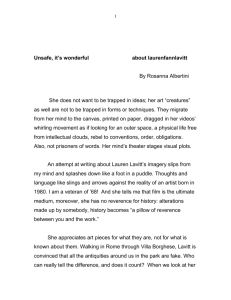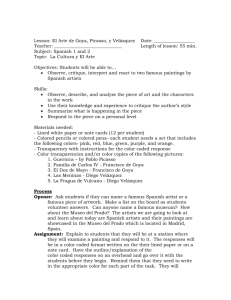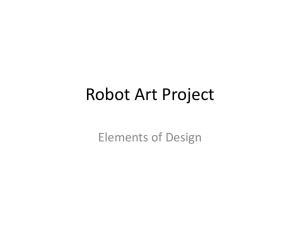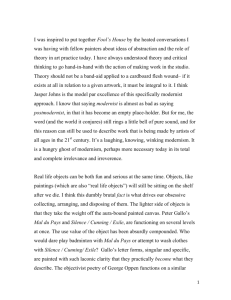"Joshua Abelow", The Junior Varsity Vol. 1, 2011
advertisement
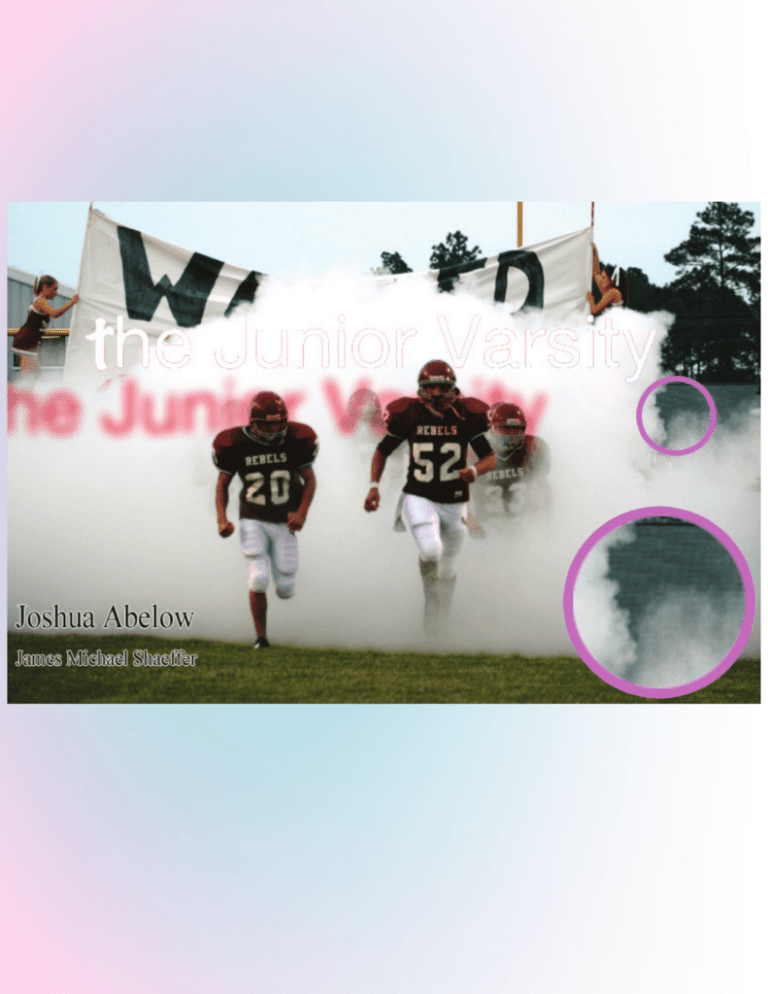
The Junior Varsity Vol. 1 Fall, 2011 Joshua Abelow Joshua Abelow has relocated the majority of his paintings from his mother’s house in Frederick, Maryland to a dingy, yet charming basement studio near the Bedford Avenue L train stop in the Brooklyn neighborhood of Williamsburg. With paintings organized in a series of rows, his studio resembles less the romantic atelier of an artist’s studio and more the backroom to an emporium of abstract art. Claiming to have already documented over nine hundred works, Abelow delineates this is only the tip of the iceberg. “We haven’t begun to document most of the drawings,” he says, as he points to a back table piled high with flat files containing compositions spanning the last ten years of his creative output. While most of the paintings exhibit modernist idioms such as geometrical shapes and dull colors, others are layered with biomorphic designs, figural drawings, jocular phrases, and occasionally the artist’s cell phone number. Initially appearing to be a few compositions reproduced ad nauseum, with further examination one can see that each painting in his multitudinous body of work is unique - for every design a color pattern is not repeated, every quip, a new background. How these paintings came to be is anything but fortuitous - Abelow has punctiliously recorded every pattern, motif, symbol and axiom in several notebooks as if every adage was a single character in his own language. He has collected every technique he has used to make a painting and systematically applied them to specific algorithms thus creating an expansive oeuvre. The end result is the construction of a prolific body of work that Abelow has at his disposal to create a new conversation in every exhibition. Self Portrait, 2011, oil on linen, 12” x 9”, and Self-Portrait, 2010, oil on linen. 16” x 12” Untitled (Abstraction “FW”), 2010, oil on burlap. 24” x 18” and Untitled (Abstraction “FV”), 2010, oil on burlap, 24” x 18” Paintings in progress What extemporaneously attracts a viewer to Michaux, Jacques Lacan, Gilles Deleuze and Félix Abelow’s work is its modernist appeal. Borrowing Guattari were parallel to inquiries of the crisis of design techniques from Bauhaus and De Stijl, faciality by artists like Dubuffet. For example, where these early motifs of avant-garde Deleuze and Guattari saw the aesthetics provide the backdrop face as something that united the for almost all of his paintings. intrinsic self with the chaos of the Abelow notes that this inclination outside world, Dubuffet’s portraits to 20th century aesthetics can performed as effigies to reality 2. partially be the influence from Both theories are alike in that the his grandmother, Paula Brunner face serves as a bridge between Abelow, an artist from Prague who an external multiplicity and the studied at Cooper Union. Ignorant perennial, internal psyche. By to her work, one can assume that combining tropes of both design she must have engaged in similar and figure in his paintings, Abelow dialogues with modernist titans exhibits this idea by giving such as Henri Matisse, Paul Klee, countenance to 20th century and the artists associated with design thus communicating the Art Brut all who are echoed in history of modernist motifs to Abelow’s art. For instance, the contemporary audiences. Fanrasue, Jean Dubuffet, 1952, oil childlike allure of his figural works and sand on canvas suggests the same feral authenticity Abelow’s exploration of sought by Jean Dubuffet. Not only modernist art is not limited to his do both share a keen sense of paintings; his flowing graphite puerile beauty, Dubuffet’s effort to drawings are analogous to similar challenge institutionalized notions pieces done by Matisse, who both of elegance by mixing paints with share an affinity for the mellifluous sand – a technique he entitled haute line. Often times these drawings by 1 pâté - are echoed by Abelow’s Abelow are done without removing the pencil from the surface of portraits painted on stretched the paper until the composition burlap. Furthermore, like Dubuffet is complete. Also constant is the and additional modernist artists, one portrayal of the artist himself, of the most reoccurent themes in characterized by a long nose and Abelow’s work is the face. wool cap often times in less than amiable situations. Although not as This affinity toward dark and as Phillip Guston’s own physiognomy and modernist satire of the artist (which he once aesthetics should not come as Self-Portrait, Joshua Abelow, 2009. depicted as a masochist flagellating a surprise to anyone, as Daniel oil on burlap 12” x 9” himself), Abelow’s portraits are akin Marcus outlines: “the story of to the humility constant within a modernist painting could be written prepubescent boy’s paranoia. Naked, painting, or as a story of the face – beginning with Manet’s penetrating a young Giorgio Di Chirico’s mouth with Olympia and ending in crisis, with Jackson Pollock’s this nose, Abelow’s illustrations of the artist reflect a Eyes in the Heat”. Marcus’s 2011 essay details how cynicism toward the creative process omnipresent in investigations of physiognomy by writers like Henri seasoned artists. 1 In English translates to “Matter Painting”, refers to raised, relief-like style of painting. Jean Fautrier along with Dubuffet used this technique along with others associated with the Post-War French informel artists. 2 Marcus, Daniel. “Eyes in the Heat: Jean Dubuffet, Cathy Wilkes, Josh Smith.” Art Forum, June 2011. While aesthetic comparisons to Dubuffet, Matisse and others are inevitable; Abelow’s conceptualization of these pieces brings him in dialogue with later conceptual artists like Sol Lewitt. If one were to compare the notebooks of Abelow and Lewitt it would become apparent how parallel each artist’s work process is. Both carefully plan out several works before any physical transformation occurs. Whereas Abelow will write down in his sketchbook instructions on how each painting is created, Lewitt’s approach is far more mathematical. For example, Lewitt fastidiously cataloged all sketches for his proposed series Incomplete Open Cubes from raw approximations to calculated grids ensuring that no shape reoccurred, reflecting his belief that “the idea becomes a machine that makes art.”1 It was this methodology toward art making that led critics in the seventies to investigate Lewitt’s scrutiny of rationalization. While most writers of the time such as Lucy Lippard and Donald Kuspit championed Lewitt as someone who rationally attempted to find universality in art, Rosalind Krauss was opposed to this observation. In her essay “Lewitt in Progress” she writes that the multiple explorations he takes into finding new forms is the opposite of logical thought and in fact the rationality that others championed him for is found not in multiples but “with only the first two or three terms.” She claims that his artwork portrays an “absurdist nominalism” that manifests that there are no “universal truths or transcendental ideas”, in other words Lewitt is reversing the nominal process by creating multiples to be categorized by a single idea. To emphasize her argument she alludes to Molloy, a text by Samuel Beckett where the protagonist labors through an irrational process of sucking stones. 2 This “absurdist nominalism” she labels Lewitt with can be applied to Abelow as well, who like Lewitt would rather physically create the infinite variables possible with each work rather than allude to the concept’s enormity. Abelow’s notebooks behave in the same matter as Lewitt’s – refraining from a proliferation of pictorial references, almost all works are outlined with instructions on how to create them. Abelow has given instructions for proper mixtures of paint along with descriptions of shapes and designs to fabricate his entire oeuvre from a rubric alone without graphic assistance. This captious note taking repeals conceptual allegories to Dubuffet’s feral approach and rather echoes the late 19th century artist and theorist Maurice Denis’ postulation “that a picture, before being a battle horse, a nude, an anecdote or whatnot, is essentially a flat surface covered with colors assembled in a certain order.” 1 Baume, Nicholas. Sol Lewitt: Incomplete Open Cubes. (Hartford, CT: Wadsworth Aleneum Museum of Art, 2001), 35. 2 Krauss, Rosalind. “Lewitt in Progress.” October. 6. (1978): 46-60. FROM MOLLOY BY SAMUEL BECKETT (SUCKING STONES EXCERPT) I took advantage of being at the seaside to lay in a store of sucking-stones. They were pebbles but I call them stones. Yes, on this occasion I laid in a considerable store. I distributed them equally between my four pockets, and sucked them turn and turn about. This raised a problem which I first solved in the following way. I had say sixteen stones, four in each of my four pockets these being the two pockets of my trousers and the two pockets of my greatcoat. Taking a stone from the right pocket of my greatcoat, and putting it in my mouth, I replaced it in the right pocket of my greatcoat by a stone from the right pocket of my trousers, which I replaced by a stone from the left pocket of my trousers, which I replaced by a stone from the left pocket of my greatcoat, which I replaced by the stone which was in my mouth, as soon as I had finished sucking it. Thus there were still four stones in each of my four pockets, but not quite the same stones. And when the desire to greatcoat, certain of not taking the same stone as the last time. And while I sucked it I rearranged the other stones in the way I have just described. And so on. But this solution did not satisfy me fully. For it did not escape me that, by an extraordinary hazard, the four stones circulating thus might always be the same four. In which case, far from sucking the sixteen stones turn and turn about, I was really only sucking four, always the same, turn and turn about. But I shuffled them well in my pockets, before I began to suck, and again, while I sucked, before transferring them, in the hope of obtaining a more general circulation of the stones from pocket to pocket. But this was only a makeshift that could not long content a man like me. So I began to look for something else ... I might do better to transfer the stones four by four, instead of one by one, that is to say, during the sucking, to take the three stones remaining in the right pocket of my greatcoat and replace them by the four in the right pocket of my trousers , and these by the four in the left pocket of my trousers, and these by the four in the left pocket of my greatcoat, and finally these by the three from the right pocket of my greatcoat, plus the one, as soon as I had finished sucking it, which was in my mouth. Yes, it seemed to me at first that by so doing I would arrive at a better result. But onfurther reflection I had to change my mind and confess that the circulation of the stones four by four came to exactly the same thing as their circulation one by one. For if I was certain of finding each time, in the right pocket of my greatcoat, four stones totally different from their immediate predecessors, the possibility nevertheless remained of my always chancing on the same stone, within each group of four, and consequently of my sucking, not the sixteen turn and turn about as I wished, but in fact four only, always the same, turn and turn about................................... elswhere than in the mode of circulation. For no matter how I caused the stones to circulate, I always ran the same risk. It was obvious that by increasing the number of my pockets I was bound to increase my chances of enjoying my stones in the way I planned, that is to say one after the other until their number was exhausted. Had I had eight pockets, Abelow’s production level undoubtedly brings him in conversation with painter Josh Smith. Smith caught the art world’s attention with his first solo show in 2003 at the Galerie Catherine Bastide in Brussels, which showcased the innumerable identities of painting by generating scores of compositions unremittingly. Although using a language of painting assumed to be investigated at length, Smith’s reprocess of Abstract expressionism ventures beyond former scrutiny of the subject1. By creating a profusion of non-pictorial canvases he destroys the aura of the singular plastic art object. “I didn’t want [the paintings] to be perceived as silly and romantic the way that painting sometimes can be” Smith says, “I wanted to make sure that regardless of what the ideas in the paintings were, they were presented in a straightforward and worthwhile way”2. The manifestation of a copious amount of paintings in a single gallery, all painted within a few months of each other, occasionally hung in a grid and with dispassionate titles did precisely this – present the viewer in the exhibition the very idea of painting, it’s epithet as a trope of the artistic process, without the redundant talismanic perversion of many works of art. Whereas Smith creates an endless body of work to destroy the aura of painting, Abelow wishes to prolong a painting’s emanation, albeit with the same expansive volume of compositions. This is partially through his process, which as said before he documents closely. In opposition to Josh Smith who viscerally responds to a canvas without prior inclination to what will occur when he paints, Abelow has calculated specifically what the painting will look like before he touches brush to canvas. Furthermore, where Smith will write his name on a canvas to showcase both ownership and style in his work, Abelow often times paints his cell phone number on images – an invitation to interact with the viewer directly instead of through the semantics of art making. In this way Abelow wishes to cross the bridge between artist and viewer much more willingly than Smith who cleverly disguises himself through a schema of multiplicity. 1 Gerhard Richter’s systematically produced non-referential paintings of the seventies and eighties were some of the first to critique Abstract expressionism’s credos of automatism and existentialism. Richter used homemade squeegee’s to rub large bands of paint applied to the canvas and through his melodic, structural process he was able to create palettes which referenced both Abstract expressionism and landscape painting – a reactionary aesthete towards Greenbergian notions of intrinsic compositions. Smith applies the same evaluation of mid-century fetishization of the painting by producing numerous works that utilize the aesthetics of Abstract expressionism. 2 Josh Smith, introduction to the catalogue, Josh Smith: Abstraction (New York and Berlin: Luhring Augustine Gallery and Holzwarth Publications, 2007), unpaginated (in 3 Volumes) Exhibition view of “84 Paintings” at Wilkinson Gallery in 2009. Fiona Mackay, Morag Keil and Manuela Gernedel The idea of painter as maker of multiples is an idea ingrained within the conscious of many contemporary artists. Besides Smith and Abelow a notable example is “84 Paintings” an exhibition at Wilkinson Gallery in London where artists Fiona Mackay (b.1984 Scotland), Morag Keil (b.1985 Scotland), and Manuela Gernedel (b.1982 Austria) exhibited paintings produced in late 2009. As the press release explains; “no emphasis was put on the project to produce a final event or exhibition, the conclusion would inevitably be 84 works”, the three artists showcased the titular amount of paintings leaning against the walls of the gallery, all of which were produced in a two-week period. Why then is there a trend in contemporary art making to make a manifold amount of paintings without a seeming passionate regard to the fetishization of the original, revered work of art? Is it a reflection on the multifarious images that proliferate our age of information? Or is it like Smith – to emphasize painting’s tropes while destroying its aura? Perhaps it’s like Lewitt – to portray the multifarious creations that can be manifested from a single idea. Unlike the artists exhibited at the Wilkinson Gallery and Josh Smith who all appear to be in a race to create the most extensive output, Abelow’s work tends to be an investigation to find individuality within multiplicity. Joshua Abelow is an artist based in New York City. He is currently represented by James Fuentes Gallery and runs the exhibition space ART BLOG ART BLOG. http://www.jamesfuentes.com/ http://joshuaabelow.com/ http://joshuaabelow.blogspot.com/ This essay was written by James Michael Shaeffer, curator based in Richmond, Virginia. He also helps run the art space REFERENCE Art Gallery http://www.jamesmichaelshaeffer.com http://www.referenceartgallery.com http://thejuniorvarsity.tumblr.com



